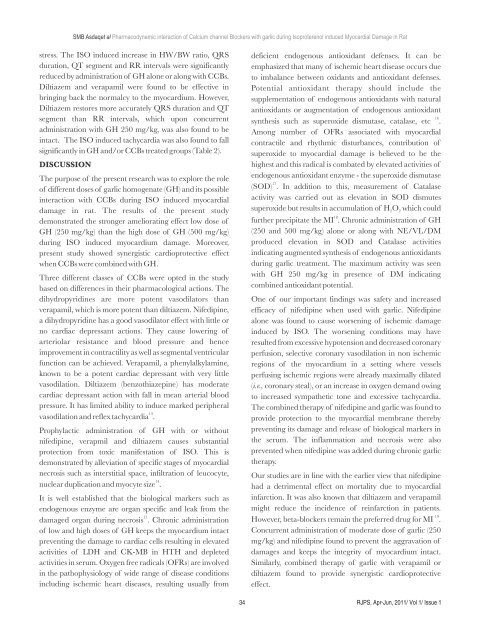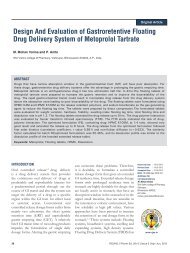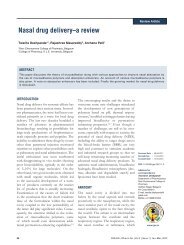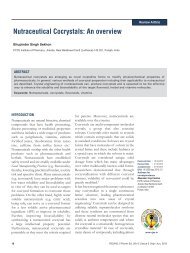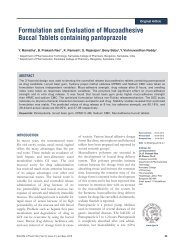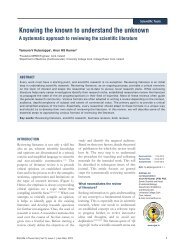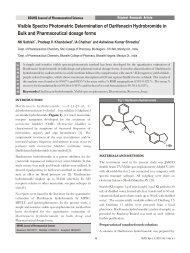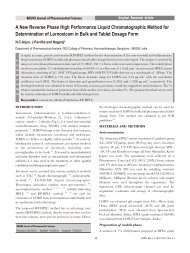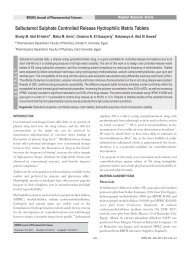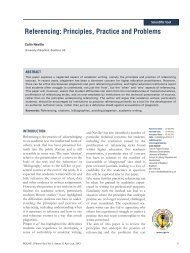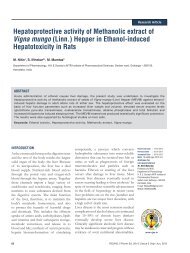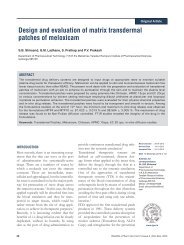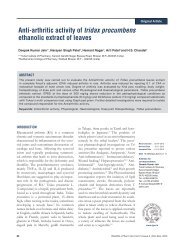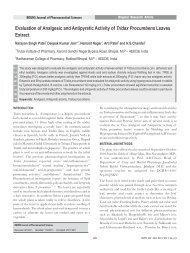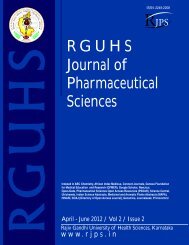final .cdr
final .cdr
final .cdr
You also want an ePaper? Increase the reach of your titles
YUMPU automatically turns print PDFs into web optimized ePapers that Google loves.
stress. The ISO induced increase in HW/BW ratio, QRS<br />
duration, QT segment and RR intervals were significantly<br />
reduced by administration of GH alone or along with CCBs.<br />
Diltiazem and verapamil were found to be effective in<br />
bringing back the normalcy to the myocardium. However,<br />
Diltiazem restores more accurately QRS duration and QT<br />
segment than RR intervals, which upon concurrent<br />
administration with GH 250 mg/kg, was also found to be<br />
intact. The ISO induced tachycardia was also found to fall<br />
significantly in GH and/or CCBs treated groups (Table 2).<br />
DISCUSSION<br />
SMB Asdaqet al Pharmacodynamic interaction of Calcium channel Blockers with garlic during Isoproterenol induced Myocardial Damage in Rat<br />
The purpose of the present research was to explore the role<br />
of different doses of garlic homogenate (GH) and its possible<br />
interaction with CCBs during ISO induced myocardial<br />
damage in rat. The results of the present study<br />
demonstrated the stronger ameliorating effect low dose of<br />
GH (250 mg/kg) than the high dose of GH (500 mg/kg)<br />
during ISO induced myocardium damage. Moreover,<br />
present study showed synergistic cardioprotective effect<br />
when CCBs were combined with GH.<br />
Three different classes of CCBs were opted in the study<br />
based on differences in their pharmacological actions. The<br />
dihydropyridines are more potent vasodilators than<br />
verapamil, which is more potent than diltiazem. Nifedipine,<br />
a dihydropyridine has a good vasodilator effect with little or<br />
no cardiac depressant actions. They cause lowering of<br />
arteriolar resistance and blood pressure and hence<br />
improvement in contractility as well as segmental ventricular<br />
function can be achieved. Verapamil, a phenylalkylamine,<br />
known to be a potent cardiac depressant with very little<br />
vasodilation. Diltiazem (benzothiazepine) has moderate<br />
cardiac depressant action with fall in mean arterial blood<br />
pressure. It has limited ability to induce marked peripheral<br />
13<br />
vasodilation and reflex tachycardia .<br />
Prophylactic administration of GH with or without<br />
nifedipine, verapmil and diltiazem causes substantial<br />
protection from toxic manifestation of ISO. This is<br />
demonstrated by alleviation of specific stages of myocardial<br />
necrosis such as interstitial space, infiltration of leucocyte,<br />
14<br />
nuclear duplication and myocyte size .<br />
It is well established that the biological markers such as<br />
endogenous enzyme are organ specific and leak from the<br />
15<br />
damaged organ during necrosis . Chronic administration<br />
of low and high doses of GH keeps the myocardium intact<br />
preventing the damage to cardiac cells resulting in elevated<br />
activities of LDH and CK-MB in HTH and depleted<br />
activities in serum. Oxygen free radicals (OFRs) are involved<br />
in the pathophysiology of wide range of disease conditions<br />
including ischemic heart diseases, resulting usually from<br />
34<br />
deficient endogenous antioxidant defenses. It can be<br />
emphasized that many of ischemic heart disease occurs due<br />
to imbalance between oxidants and antioxidant defenses.<br />
Potential antioxidant therapy should include the<br />
supplementation of endogenous antioxidants with natural<br />
antioxidants or augmentation of endogenous antioxidant<br />
16<br />
synthesis such as superoxide dismutase, catalase, etc .<br />
Among number of OFRs associated with myocardial<br />
contractile and rhythmic disturbances, contribution of<br />
superoxide to myocardial damage is believed to be the<br />
highest and this radical is combated by elevated activities of<br />
endogenous antioxidant enzyme - the superoxide dismutase<br />
17<br />
(SOD) . In addition to this, measurement of Catalase<br />
activity was carried out as elevation in SOD dismutes<br />
superoxide but results in accumulation of H2O 2 which could<br />
18<br />
further precipitate the MI . Chronic administration of GH<br />
(250 and 500 mg/kg) alone or along with NE/VL/DM<br />
produced elevation in SOD and Catalase activities<br />
indicating augmented synthesis of endogenous antioxidants<br />
during garlic treatment. The maximum activity was seen<br />
with GH 250 mg/kg in presence of DM indicating<br />
combined antioxidant potential.<br />
One of our important findings was safety and increased<br />
efficacy of nifedipine when used with garlic. Nifedipine<br />
alone was found to cause worsening of ischemic damage<br />
induced by ISO. The worsening conditions may have<br />
resulted from excessive hypotension and decreased coronary<br />
perfusion, selective coronary vasodilation in non ischemic<br />
regions of the myocardium in a setting where vessels<br />
perfusing ischemic regions were already maximally dilated<br />
(i.e., coronary steal), or an increase in oxygen demand owing<br />
to increased sympathetic tone and excessive tachycardia.<br />
The combined therapy of nifedipine and garlic was found to<br />
provide protection to the myocardial membrane thereby<br />
preventing its damage and release of biological markers in<br />
the serum. The inflammation and necrosis were also<br />
prevented when nifedipine was added during chronic garlic<br />
therapy.<br />
Our studies are in line with the earlier view that nifedipine<br />
had a detrimental effect on mortality due to myocardial<br />
infarction. It was also known that diltiazem and verapamil<br />
might reduce the incidence of reinfarction in patients.<br />
19<br />
However, beta-blockers remain the preferred drug for MI .<br />
Concurrent administration of moderate dose of garlic (250<br />
mg/kg) and nifedipine found to prevent the aggravation of<br />
damages and keeps the integrity of myocardium intact.<br />
Similarly, combined therapy of garlic with verapamil or<br />
diltiazem found to provide synergistic cardioprotective<br />
effect.<br />
RJPS, Apr-Jun, 2011/ Vol 1/ Issue 1


